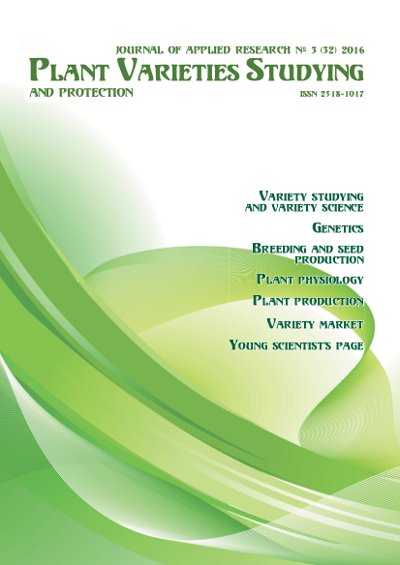Bioinformatic analysis of maize gene encoding starch branching enzyme SBEIIb.
DOI:
https://doi.org/10.21498/2518-1017.3(32).2016.75972Keywords:
ae1 gene, starch branching enzyme SBEIIb, maize, bioinformaticAbstract
Purpose. Investigation of maize ae1 gene polymorphism by bioinformatic methods.
Methods. Global and local alignment of the nucleotide and amino acid sequences, in silico translation and transcription, translates modeling, primers design, phylogenetic analysis.
Results. 255 nucleotide sequences of maize аe1 gene, 500 amino acid sequences of homology translates of maize ae1 gene (SBEIIb enzyme homologs) and 100 mRNA expressed from the maize ae1 gene were analyzed to establish phylogenetic relationships. Polymorphism of maize ae1 gene different regions was investigated by bioinformatic methods. Modeling of the maize enzyme SBEIIb was performed.
Conclusions. According to the results of amino acid sequences of SBEIIb enzyme homologs alignment, it was found that ae1 gene orthologs are present only in monocots, paralogs – in monocots, dicots, and other taxa, including algae and animals. Based on the results of alignment of plants mRNA from which enzyme SBEIIb is translated, maize ae1 gene orthologs and the nearest paralogs encoding starch branching enzymes with chloroplast localization were defined; this suggests a possible origin of ae1 gene due to duplication of the gene encoding the 1,4-alpha-glucan-branching enzyme 2 with chloroplast or amyloplast localization. In the maize ae1 gene structure, regions were found that include polymorphic sites not defined previously. For the polymorphic sites design primers were developed that allowed to differentiate the maize lines. It was determined that the detection of polymorphism in theory can influence the enzyme function and, as a result, change the concentration of amylopectin in maize grain.
Downloads
References
Farooq, M., Wahid, A., & Siddique, K. H. M. (2014). Physiology of grain development in cereals. In M. Pessarakli (Ed.), Handbook of Plant and Crop Physiology. (3rd ed.). (pp. 301–308). Boca Raton, FL, USA: CRC Press, Taylor & Francis Publishing Group.
James M., & Myers, A. (2009). Seed starch synthesis. In J. L. Bennetzen & S. C. Hake (Eds), Handbook of Maize: Its Biology. (pp. 439–456). New York, USA: Springer. doi: 10.1007/978-0-387-79418-1_22.
Agrawal, G. K., & Rakwal, R. (Eds). (2012). Seed development: OMICS technologies toward improvement of seed quality and crop yield. Dordrecht, NL: Springer. doi: 10.1007/978-94-007-4749-4
Hennen-Bierwagen, T. A, Liu, F., Marsh, R. S., Kim, S., Gan, Q., Tetlow, I. J., … Myers, A. M. (2008). Starch biosynthetic enzymes from developing maize endosperm associate in multisubunit complexes. Plant Physiol., 146(4), 1892–1908. doi: 10.1104/pp.108.116285
Hennen-Bierwagen, T. A., & Myers, A. M. (2013). Genomic specification of starch biosynthesis in maize endosperm. In P. W. Becraft (Ed.), Seed Genomics. (pp. 123–137). Hoboken, NJ: John Wiley & Sons. doi: 10.1002/9781118525524.ch7
National Center for Biotechnology Information (NCBI) data base. (n.d.). Retrieved from http://www.ncbi.nlm.nih.gov
Smith, T. F., & Waterman, M. S. (1981). Identification of common molecular subsequences. J. Mol. Biol., 147(1), 195–197. doi: 10.1016/0022-2836(81)90087-5
Needleman, S. B., & Wunsch, C. D. (1970). A general method applicable to the search for similarities in the amino acid sequence of two proteins. J. Mol. Biol., 48(3), 443–453.
Okonechnikov, K., Golosova, O., & Fursov, M. (2012). Unipro UGENE: a unified bioinformatics toolkit. Bioinformatics, 28(8), 1166–1167. doi: 10.1093/bioinformatics/bts091
Arnold, K., Bordoli, L., Kopp, F., & Schwede, T. (2006). The SWISS-MODEL workspace: a web-based environment for protein structure homology modeling. Bioinformatics, 22(2), 195–201. doi: 10.1093/bioinformatics/bti770
Sneath, P. H. A., & Sokal, R. R. (1973). Numerical taxonomy: The principles and practice of numerical classification. San Francisco: W. H. Freeman & Co.
Tamura, K., Peterson, D., Peterson, N., Stecher, G., Nei, M., & Kumar, S. (2011). MEGA5: molecular evolutionary genetics analysis using maximum likelihood, evolutionary distance, and maximum parsimony methods. Mol. Biol. Evol., 28(10), 2731–2739. doi: 10.1093/molbev/msr121
Tajima, F. (1989). Statistical method for testing the neutral mutation hypothesis by DNA polymorphism. Genetics, 123(3), 585–595.
Downloads
Published
How to Cite
Issue
Section
License
Copyright (c) 2016 Plant varieties studying and protection

This work is licensed under a Creative Commons Attribution-ShareAlike 4.0 International License.
Our journal abides by the CREATIVE COMMONS copyright rights and permissions for open access journals.
Authors, who are published in this journal, agree to the following conditions:
1. The authors reserve the right to authorship of the work and pass the first publication right of this work to the journal under the terms of a Creative Commons Attribution License, which allows others to freely distribute the published research with the obligatory reference to the authors of the original work and the first publication of the work in this journal.
2. The authors have the right to conclude separate supplement agreements that relate to non-exclusive work distribution in the form in which it has been published by the journal (for example, to upload the work to the online storage of the journal or publish it as part of a monograph), provided that the reference to the first publication of the work in this journal is included.


























 Ukrainian Institute for Plant Varieties Examination
Ukrainian Institute for Plant Varieties Examination  Селекційно-генетичний інститут
Селекційно-генетичний інститут Institute of Plant Physiology and Genetics of the National Academy of Sciences of Ukraine
Institute of Plant Physiology and Genetics of the National Academy of Sciences of Ukraine
 The National Academy of Agrarian Sciences of Ukraine
The National Academy of Agrarian Sciences of Ukraine